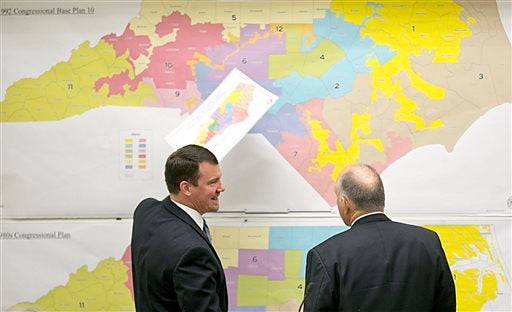Paul O’Connor: Imagine a different NC legislature
Published 9:51 pm Tuesday, June 13, 2017

- State Sens. Dan Soucek, left, and Brent Jackson review historical maps during a Senate Redistricting Committee meeting in 2016, in Raleigh. (Corey Lowenstein/The News & Observer via AP)
RALEIGH — Over the last four years, Republican legislators, fueled by veto-proof majorities in both houses, have refashioned the state’s tax code, voting laws, and its policies on education, the environment and social issues.
After the U.S. Supreme Court ruled that North Carolina’s legislative districts are unconstitutional and Gov. Roy Cooper called for a special redistricting session, it’s natural to ask how state and legislative politics might have been different had Republicans drawn legal districts in 2011.
Let’s proceed on two assumptions. First, with legal legislative maps, the GOP still would have won control of the Assembly in each of the last three elections. Second, their majorities would have been smaller and more reflective of the state’s purple make-up.
The size of a party’s majority drives its legislative tactics. With a small majority, party loyalty is essential in committee and chamber votes. But in party caucuses, as members try to form a solid front for public votes, there is naturally more discussion and compromise.
A larger majority creates a steamroller effect. A majority in the caucus can run over the concerns of individual or small groups of fellow-party legislators.
A legal map would have meant more competitive districts where candidates would need crossover support from independents and members of the other party in general elections. Thus, legal maps would force a moderating of partisan fervor in favor of legislation that is acceptable to a wider majority of voters.
Consider the big Republican tax bill. It cut taxes for the wealthy and for businesses but raised taxes on some middle-income families and small businesses. Had the state been districted so that more Republican legislators faced competitive re-election campaigns against viable Democrats, there would have been pressure on those Republicans to moderate the bill, especially if the GOP leadership could not get to a majority without their votes.
With so few districts really competitive, Republicans were able to safely support it and Democrats to safely oppose it.
But what if Democrats had to worry about winning re-election after opposing the bill? They might have been willing to sign on, and in making that willingness known in a tight legislative fight, they might have won some concessions from the Republican leadership. That kind of thing happened in the 2011 General Assembly, before redistricting.
Having legal maps would have also brought former Gov. Pat McCrory into play more often. A weak governor to begin with, he was undermined by his own party’s veto-proof majority. With legal districts, his veto would have counted and he might have set out on a more moderate course.
Would he have signed House Bill 2, the bathroom bill, had he not known that a veto would be only a vain effort and one that would anger his own party’s base? No one knows.
The HB 2 politics would have been different. Republicans might not have proposed it or more Democrats might have supported it.
On the second point, remember that some Democrats did support HB 2. The Republican strategy of creating a wedge issue for Democrats in the 2016 election might have worked better had districts been competitive and had Democrats had to worry about re-election for opposing it.
Gerrymandered districts led to a legislature representative of the two party bases but not of the broad middle of the state electorate. With these illegal districts, Republicans got away with almost any initiative that fired up their right-wing base. Democrats, dealt out of the process because of their small numbers, suffered no consequences for opposing everything.
Let’s hope that new maps restore some competitive balance and, thus, better government.
Paul T. O’Connor has covered state government for 39 years.

